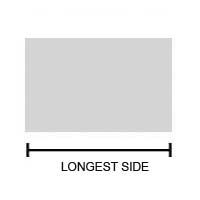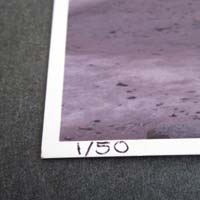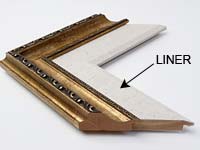| Glossary Of Giclee Terms
[18] |
L
Lamination Lamination is a process of bonding thin layers of material together to create a composite structure with improved strength, durability, and surface properties. In printing and graphic arts, lamination involves applying a thin layer of clear plastic film, such as polyester or polypropylene, to the surface of printed materials using heat and pressure. Lamination protects printed materials from moisture, abrasion, UV radiation, and other environmental factors, extending their lifespan and enhancing their appearance. Laminated prints are commonly used for outdoor signage, banners, posters, menus, ID cards, and other applications requiring durability and weather resistance. |
Landscape Orientation Refers to the angle at which the framed or canvas image is hung. Landscape oriented images are those displayed lengthwise, so that the top edge (parallel to the floor) is the long dimension of the painting, and the side edge is the short dimension.
Also referred to as "horizontal orientation".
The opposite of "portrait orientation". |
 |
Laser Engraving Laser engraving is a versatile and precise method of creating deep, permanent marks, patterns, or designs on a variety of materials, including metals, plastics, wood, leather, glass, and stone. In laser engraving, the focused laser beam interacts with the material's surface, removing material through ablation or vaporization to create recessed or raised areas with high resolution and detail.
Laser engraving offers advantages such as high speed, accuracy, repeatability, and the ability to produce intricate designs, text, logos, and images with sharp edges and fine details. Laser engraving is used in various industries and applications, including awards and trophies, signage, jewelry, woodworking, personalized gifts, architectural models, and industrial part marking. Laser engraving systems may employ different laser sources, including CO2 lasers, fiber lasers, and diode lasers, each offering specific advantages in terms of wavelength, power, and material compatibility for different engraving applications. |
| Latex Ink A relatively new type of inkjet ink,offered as an alternative to solvent inks. A water carrier is mixed with a polymer dye, which is then applied to the substrate using heat. Unlike traditional solvent inks, latex inks are odorless, which eliminates ventilation issues. |
Lens A lens is a transparent optical component or device that refracts or bends light rays passing through it, focusing or diverging them to form an image. Lenses are essential elements in optical systems, cameras, telescopes, microscopes, eyeglasses, and other imaging devices, where they play a crucial role in magnifying, magnifying, and manipulating light to capture, project, or view images.
Lenses can be made from various materials, such as glass, plastic, and crystalline substances, and come in different shapes, sizes, and configurations, including convex lenses, concave lenses, cylindrical lenses, and aspherical lenses. Lenses exhibit properties such as focal length, optical power, aberrations, and aperture size, which determine their optical performance and imaging characteristics. By controlling the curvature and thickness of the lens surfaces, designers can achieve precise control over the focusing, resolution, and distortion of images in optical systems. |
Lens Flare Lens flare is a visual phenomenon characterized by unwanted artifacts or patterns of light that appear in an image as a result of light sources hitting the camera lens at oblique angles. Lens flare can manifest as streaks, circles, or geometric shapes of varying intensity and color, depending on the characteristics of the lens, the angle of the light source, and the position of the camera. Lens flare is caused by internal reflections and scattering of light within the lens elements, particularly when shooting towards bright light sources such as the sun or artificial light sources.
While lens flare is often considered a technical flaw and may detract from the overall image quality, it can also be used creatively to add visual interest, mood, and atmosphere to a photograph. Some photographers intentionally incorporate lens flare into their compositions to create artistic effects or evoke a sense of warmth, nostalgia, or drama. Lens hoods and lens coatings are commonly used to minimize or prevent lens flare by reducing the amount of stray light entering the lens and improving contrast and color saturation in images. |
Lens Hood A lens hood is a cylindrical or conical accessory that attaches to the front of a camera lens to block unwanted light from entering the lens and causing lens flare, ghosting, or reduced contrast in images. Lens hoods are designed to extend beyond the front element of the lens, shading it from direct sunlight, stray light, and other sources of glare.
By preventing extraneous light from hitting the lens at oblique angles, lens hoods help maintain optimal image quality, color saturation, and contrast, especially in bright outdoor conditions or when shooting towards the sun. Lens hoods come in various shapes and sizes to match specific lens designs and focal lengths. Some lens hoods are reversible or collapsible for compact storage when not in use. While lens hoods are primarily used to improve image quality, they also provide physical protection for the front lens element against accidental bumps, scratches, and damage. |
Lens Mount A lens mount refers to the mechanical interface and attachment mechanism used to connect a camera lens to a camera body. Lens mounts vary depending on the camera system and manufacturer, with each mount design featuring specific dimensions, alignment pins, and electronic contacts for communication between the lens and camera body. Common lens mount systems include Canon EF, Nikon F, Sony E, Fujifilm X, and Micro Four Thirds, among others.
Each lens mount is designed to ensure precise alignment and secure attachment of the lens to the camera body, enabling proper focusing, aperture control, and communication of lens data and metadata. Lens mounts may also support features such as autofocus, image stabilization, and electronic lens control, depending on the compatibility and specifications of the camera and lens system. |
Lens Speed Lens speed, also known as lens aperture or lens brightness, refers to the maximum aperture diameter of a camera lens, expressed as a numerical f-stop value. A lens with a larger maximum aperture (smaller f-stop number) is considered "faster" because it allows more light to pass through the lens to the camera sensor, enabling faster shutter speeds and better performance in low-light conditions.
Fast lenses are desirable for situations where capturing fast-moving subjects, achieving shallow depth of field, or shooting in dimly lit environments is required. The speed of a lens is determined by its maximum aperture size relative to the focal length of the lens. For example, a lens with a maximum aperture of f/2.8 is considered faster than a lens with a maximum aperture of f/4.0. Fast lenses are commonly used in portrait photography, sports photography, and photojournalism, where the ability to capture sharp, well-exposed images in challenging lighting conditions is essential. |
| Limited Edition In printmaking, multiples of a print struck from the same plate may be limited to a certain number of copies. This also refers to other forms of published artwork that are identical, usually published at the same time, and limited to a quoted number. For prints, edition numbers are conventionally marked in pencil using fraction format: the bottom number indicates the total number of prints in the edition, and the top number indicates the order in which the print was signed. The publisher undertakes not to produce more than edition size. The smaller the edition size, the more rare the print, and hence the higher the potential value. Edition sizes range from an edition of 2 to thousands. In practice, editions of more than 750 prints have little, if any, extra value. |
 |
| Limited Edition Print When an artist prints a run of the same image, they determine how many of that image are to be printed. If they choose to print only 100, or 1000 copies of one image, it is limited edition. Each print will usually feature the print number (34/100) and the artist's signature. The more exclusive the piece (the fewer prints), the more expensive and valuable. |
Linen Canvas Artist's canvas is make from a variety of fabrics. Linen and cotton are the most common.
Linen is more expensive. It is longer lasting, due in part to the oils retained in the canvas that keep it pliable, and less likely to expand, due to the equally weighted threads used to construct the canvas. |
Liner A frame molding used within the outer molding/picture frame, sometimes called a "linen liner" or "insert". The may be covered with fabric, such as velvet or linen. Many liners are made from fully finished frame stock, including gold or silver. The liner serves the same purpose as a mat: to provide a distraction-free space between the art and the frame, and enhance the artwork.
Liners are paired with stretched and mounted canvas prints or paintings, and do not require a clear glass or acrylic cover. A liner may also be used on large, glass-covered artwork, as the largest mat size available is 32x40". If it is more than 2 1/2 inches wide, it is called a "panel". 
Order online: Linen Liners |
 |
| Linocut Linocut is a printmaking technique in which a design is carved into the surface of a linoleum block using cutting tools, leaving raised areas that will receive ink for printing. The linoleum block is then inked with a roller, and paper is pressed onto the block to transfer the inked design onto the paper. Linocut prints are characterized by their bold lines, textures, and graphic quality, resulting from the relief surface of the linoleum block. Artists can create multiple prints from a single linoleum block, varying the colors, papers, and printing techniques to achieve different effects. Linocut is a versatile and accessible printmaking technique popular among artists, illustrators, and printmakers for its expressive potential and tactile qualities. |
Lithograph A copy of a work that is created by the artist himself (ie: not a print created years later from a digital image).
The artist creates a mirror image of the artwork using grease pencils on stone. Oil-based ink is then applied to the piece, and bonds with the grease but avoids the uncolored areas. Canvas or paper is then laid over the plate and pressed to transfer the ink onto the material. The plate is then re-inked for the next sheet of material. |
Lithography The process of producing a picture, writing, or the like, on a flat, specially prepared stone, with some greasy or oily substance, and of taking ink impressions from this as in ordinary printing.
It was invented in 1796 by German author Alois Senefelder as a cheap method of publishing theatrical works. Lithography can be used to print text or artwork onto paper or other suitable material. |
Luminance Luminance refers to the brightness or intensity of light emitted or reflected from a surface, as perceived by the human eye. In digital imaging and color science, luminance is one of the components of color representation, along with chrominance. Luminance represents the black-and-white information or brightness values in an image, while chrominance represents the color information or hue and saturation values.
Luminance is often measured in units such as candelas per square meter (cd/m²) or relative values on a scale from 0 to 100, with 0 representing absolute black and 100 representing the brightest white. In digital imaging, luminance values are typically represented in grayscale images or luminance channels of color images, where variations in luminance contribute to contrast, tonal range, and overall image brightness. |
| Lustre Finish A semi-glossy finish that reflects light without compromising the image with a visible reflection. |
|
© 2002-2024 - KeenART Media Ltd.
|
|
| |
|

